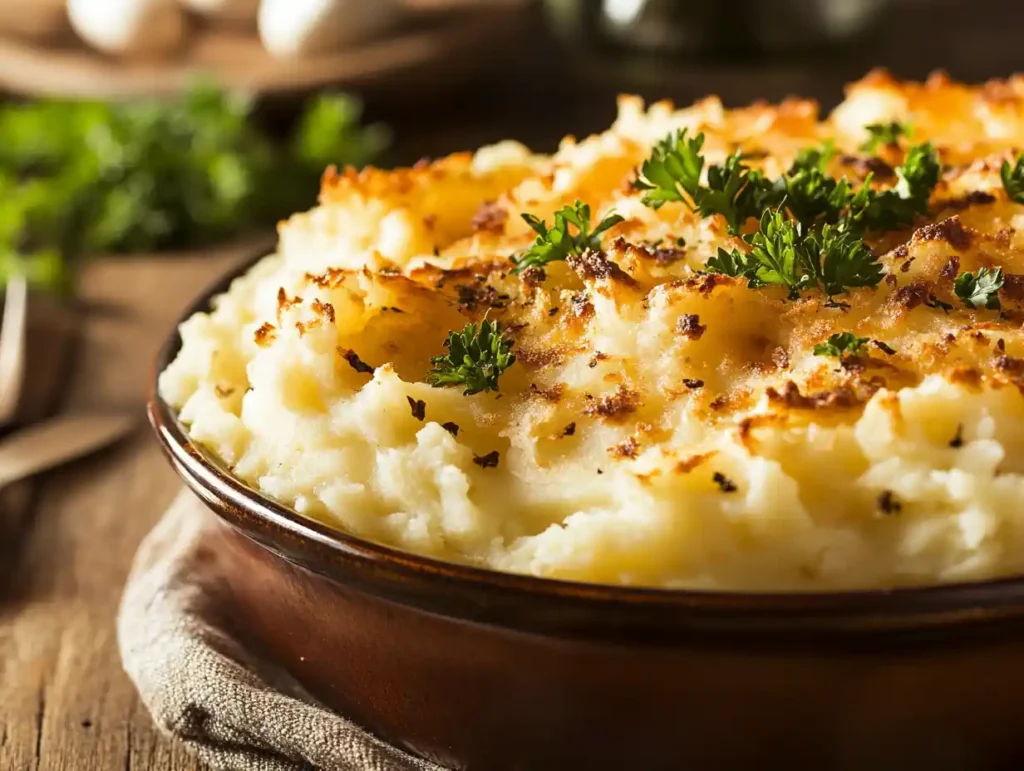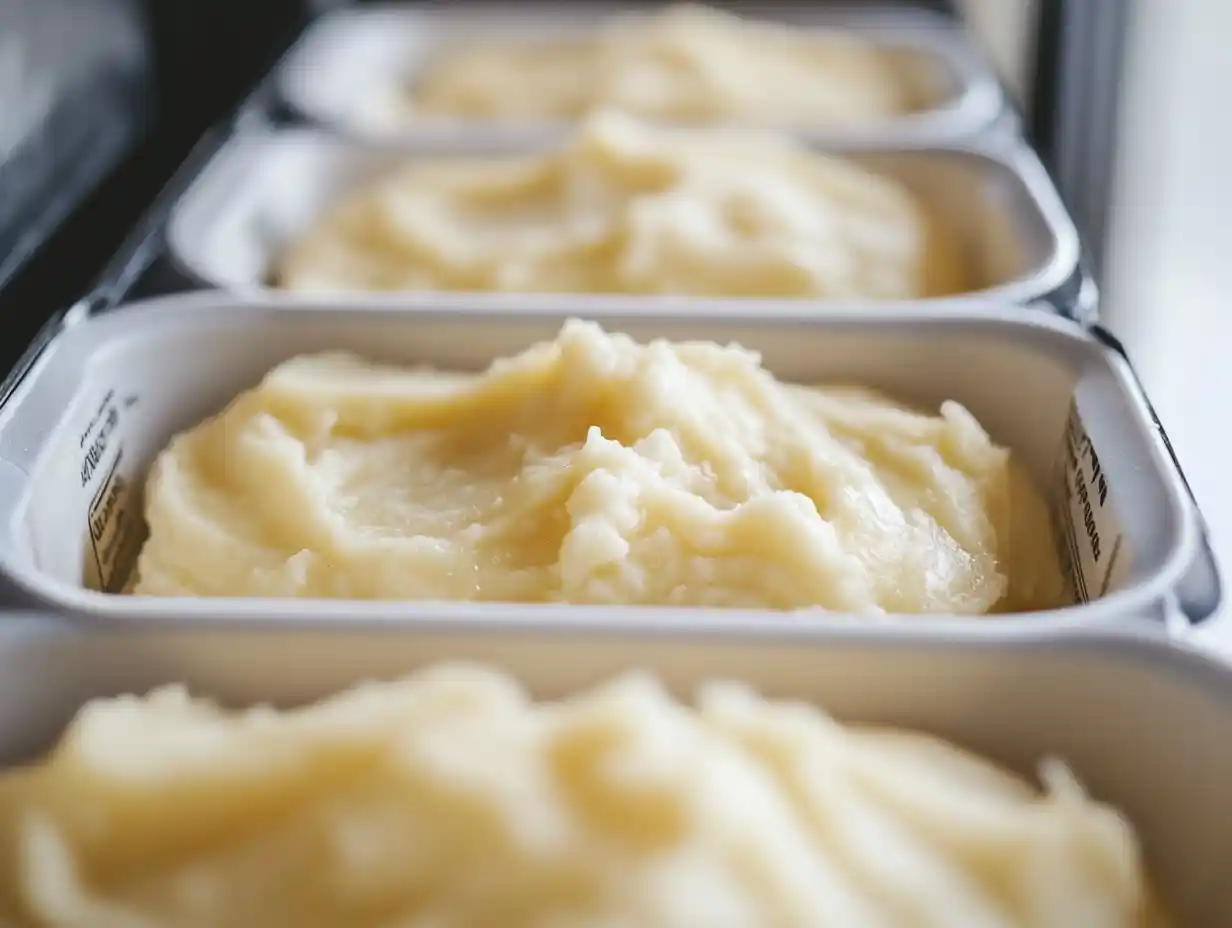Introduction
Frozen mashed potatoes are a convenient option for quick meals, but many people wonder—is frozen mashed potato any good? Whether you’re looking to save time or reduce food waste, frozen mashed potatoes can be a great addition to your kitchen. However, questions about taste, texture, and nutritional value often come up.
In this article, we’ll explore everything you need to know about frozen mashed potatoes. From how they’re made and stored to their flavor and reheating methods, we’ll provide tips to ensure they taste as good as fresh ones. We’ll also look at ways to enhance their flavor and get the most out of this handy food item.
What Are Frozen Mashed Potatoes?
How Frozen Mashed Potatoes Are Made
Frozen mashed potatoes are typically prepared from cooked and mashed potatoes that are blended with butter, milk, or cream. They are pre-seasoned and then frozen to preserve freshness and flavor. Commercially frozen mashed potatoes are often flash-frozen to prevent the formation of ice crystals, ensuring they retain their smooth texture.
Homemade mashed potatoes can also be frozen by portioning them into airtight containers or freezer bags. Adding extra butter or cream before freezing helps to maintain moisture and prevent dryness when reheated.
Types of Frozen Mashed Potatoes Available
There are different varieties of frozen mashed potatoes available in stores, including:
- Plain Mashed Potatoes – Basic mashed potatoes with minimal seasoning.
- Flavored Mashed Potatoes – Options with garlic, herbs, or cheese for added flavor.
- Dairy-Free or Vegan Options – Variants made with plant-based ingredients for dietary preferences.
- Instant Frozen Mashed Potatoes – Pre-portioned servings designed for quick preparation.
Are Frozen Mashed Potatoes Healthy?
Nutritional Value of Frozen Mashed Potatoes
Frozen mashed potatoes can be a nutritious addition to your diet when consumed in moderation. They are rich in carbohydrates, which provide energy, and contain important vitamins and minerals such as vitamin C, potassium, and fiber. Many brands also include added fats like butter and cream, which contribute to the calorie content but also enhance flavor and texture.
A typical serving of frozen mashed potatoes (about 1 cup) contains:
- Calories: 150–200 kcal
- Carbohydrates: 25–30 grams
- Protein: 2–4 grams
- Fat: 5–10 grams
- Fiber: 2–3 grams
However, the nutritional profile can vary based on the ingredients used. Some products may have added preservatives, artificial flavorings, or high sodium content, so it’s important to check the label before purchasing.
Ingredients and Preservatives to Watch For
When selecting frozen mashed potatoes, keep an eye out for:
- Artificial Preservatives – Some frozen varieties contain additives to extend shelf life, which may not suit those looking for all-natural options.
- Sodium Levels – Pre-packaged frozen mashed potatoes can be high in salt, so consider low-sodium versions if you’re watching your intake.
- Trans Fats and Oils – Avoid products with hydrogenated oils, as they can negatively impact heart health.
For those with dietary restrictions, many brands now offer gluten-free, dairy-free, or organic options to cater to specific needs.
Do Frozen Mashed Potatoes Taste Good?

Flavor and Texture Comparison with Fresh Mashed Potatoes
Frozen mashed potatoes often taste quite similar to fresh ones, especially when prepared with butter and cream. The freezing process helps preserve flavor, but there may be slight changes in texture. After thawing, frozen mashed potatoes might be a bit grainier or drier compared to freshly made ones.
To enhance flavor and texture, you can:
- Add extra butter, cream, or milk while reheating to make them creamier.
- Stir in garlic powder, chives, or cheese for added richness and flavor.
- Use a hand mixer to whip the potatoes for a smoother consistency.
Factors Affecting Taste After Freezing
Several factors can influence the taste and texture of frozen mashed potatoes:
- Fat Content – Mashed potatoes with higher fat content (from butter or cream) freeze and reheat better.
- Storage Method – Proper packaging in airtight containers prevents freezer burn, which can affect taste.
- Reheating Techniques – Gentle reheating methods, like stovetop or oven baking, help maintain flavor and texture better than microwaving.
How to Cook Frozen Mashed Potatoes
Frozen mashed potatoes are incredibly versatile and can be reheated using different methods. The key is to restore their creamy texture while keeping them flavorful.
Oven Method
- Preheat the oven to 350°F (175°C).
- Place the frozen mashed potatoes in an oven-safe dish.
- Cover the dish with aluminum foil to trap moisture and prevent drying out.
- Bake for 20–30 minutes, stirring halfway through.
- Add a splash of milk, butter, or cream if the potatoes seem dry.
Stovetop Method
- Transfer the frozen mashed potatoes into a saucepan.
- Heat over low to medium heat, stirring frequently.
- Add milk, cream, or butter gradually while stirring to smooth out the texture.
- Cook for 10–15 minutes until the potatoes are heated evenly.
Microwave Method
- Place the frozen mashed potatoes in a microwave-safe bowl.
- Cover the bowl with a lid or damp paper towel to retain moisture.
- Heat on medium power for 2–3 minutes, then stir.
- Repeat heating in 1–2 minute intervals, stirring each time, until thoroughly heated.
- Add butter or milk if needed for extra creaminess.
Tips for Reheating Without Losing Flavor
- Always add extra butter, cream, or cheese to prevent dryness.
- Stir frequently to distribute heat evenly and avoid lumps.
- Avoid overheating, as it can lead to gummy or gluey textures.
- For extra flavor, sprinkle in garlic powder, herbs, or shredded cheese before serving.
Improving the Flavor of Frozen Mashed Potatoes
Even though frozen mashed potatoes are convenient, they can sometimes lack the freshness of homemade versions. Luckily, a few simple enhancements can elevate their taste.
Add Rich Ingredients
- Butter and Cream: Incorporate extra butter and cream during reheating to create a silky texture.
- Cheese: Stir in cheddar, parmesan, or cream cheese for a richer flavor.
- Herbs and Spices: Sprinkle garlic powder, onion powder, paprika, or parsley to add depth to the taste.
Creative Ways to Enhance Flavor
- Roasted Garlic Infusion: Mix in roasted garlic for a gourmet twist.
- Sour Cream or Greek Yogurt: Add tanginess and extra creaminess by folding in a spoonful of sour cream or yogurt.
- Bacon Bits: Sprinkle crispy bacon bits for added crunch and smoky flavor.
- Chives or Green Onions: Garnish with fresh herbs to make the dish visually appealing and flavorful.
Pros and Cons of Frozen Mashed Potatoes
Benefits of Frozen Mashed Potatoes
- Convenience: They save time in meal preparation, especially for large gatherings or busy schedules.
- Long Shelf Life: Frozen mashed potatoes can last 2–3 months when stored properly, reducing food waste.
- Versatility: They can be used as a side dish or in recipes like shepherd’s pie and casseroles.
- Consistent Flavor: Many store-bought brands ensure consistent seasoning and texture.
Drawbacks to Consider
- Texture Changes: Frozen mashed potatoes may sometimes turn watery or grainy after reheating.
- Preservatives: Some brands may contain artificial preservatives or high sodium levels.
- Storage Requirements: Proper sealing is essential to avoid freezer burn and maintain flavor.
- Limited Freshness: While frozen mashed potatoes taste good, they may lack the freshness and fluffiness of homemade ones.
How Long Do Frozen Mashed Potatoes Last?
Frozen mashed potatoes can last a long time if stored correctly, making them a convenient option for meal planning. However, it’s important to know their shelf life and storage tips to maintain quality.
Proper Storage Methods
To keep frozen mashed potatoes fresh, follow these storage tips:
- Use Airtight Containers – Store mashed potatoes in airtight, freezer-safe containers to prevent air exposure and freezer burn.
- Freezer Bags for Portioning – Flatten mashed potatoes in freezer bags to save space and make thawing quicker.
- Double Layer Protection – Wrap the potatoes in plastic wrap before placing them in a container for extra protection.
- Label and Date the Container – Always label containers with the freezing date to monitor freshness.
Shelf Life of Frozen Mashed Potatoes
- Homemade Mashed Potatoes – Best consumed within 2–3 months for optimal flavor and texture.
- Store-Bought Frozen Mashed Potatoes – Typically have a shelf life of 6–12 months due to commercial freezing methods and preservatives.
Signs That Frozen Mashed Potatoes Have Gone Bad
Frozen mashed potatoes should be discarded if you notice:
- Off Smell: Sour or unusual odors indicate spoilage.
- Discoloration: Yellow or gray spots can be signs of freezer burn.
- Dry, Grainy Texture: While some dryness is normal, excessive dryness may mean the potatoes are no longer suitable for eating.
- Mold Growth: Any visible mold means the mashed potatoes should be thrown out immediately.
Best Brands for Frozen Mashed Potatoes
If you prefer buying frozen mashed potatoes instead of making them at home, several brands offer high-quality options.
Popular Store-Bought Options
- Idahoan Frozen Mashed Potatoes – Known for their creamy texture and buttery flavor.
- Bob Evans Original Mashed Potatoes – Pre-cooked and easy to reheat, offering a homemade taste.
- Ore-Ida Frozen Mashed Potatoes – Popular for their affordability and consistent quality.
- Simply Potatoes Homestyle Mashed – Fresh-tasting mashed potatoes made with real ingredients.
- Alexia Mashed Yukon Gold Potatoes – Organic and flavored options for those looking for natural ingredients.
Homemade vs. Store-Bought Frozen Mashed Potatoes
While store-bought frozen mashed potatoes are convenient, homemade versions allow you to control the ingredients, making them healthier and fresher. Homemade mashed potatoes are also customizable, allowing you to add flavors like garlic, cheese, or herbs before freezing. However, store-bought varieties save time and are ideal for quick preparation.
Can You Freeze Homemade Mashed Potatoes?
How to Freeze Homemade Mashed Potatoes
Freezing homemade mashed potatoes is simple and ensures you always have a ready-to-go side dish.
- Cool Completely – Allow the mashed potatoes to cool to room temperature before freezing.
- Add Butter or Cream – Incorporate extra butter or cream to maintain moisture during freezing and reheating.
- Portion into Containers – Divide the mashed potatoes into meal-sized portions to make thawing and reheating easier.
- Seal Tightly – Use freezer-safe bags or airtight containers to prevent freezer burn.
- Label and Freeze – Write the date on the containers and store them in the freezer for up to 3 months.
Steps to Maintain Flavor and Texture
- Avoid Overcooking Before Freezing: Cook the potatoes just until tender, not mushy, to help retain their structure.
- Double-Wrap for Protection: Use plastic wrap followed by foil for extra freshness.
- Reheat with Moisture: Always add milk, cream, or butter while reheating to bring back their creamy texture.
Alternative Uses for Frozen Mashed Potatoes

Frozen mashed potatoes aren’t just for reheating as a side dish—they can be transformed into creative meals and recipes. Their creamy texture and versatility make them a great base for various dishes.
Shepherd’s Pie and Casseroles
Mashed potatoes are perfect for topping casseroles like shepherd’s pie. Simply spread the thawed mashed potatoes over cooked meat and vegetables, then bake until golden and bubbly. This method creates a hearty and filling dish that’s ideal for family dinners.
Another option is to layer mashed potatoes in a baked potato casserole. Mix in cheese, bacon bits, and sour cream, then bake for a creamy and rich side dish.
Potato Pancakes and Croquettes
Frozen mashed potatoes can easily be turned into crispy potato pancakes or croquettes.
- Potato Pancakes: Mix thawed mashed potatoes with an egg, flour, and seasonings. Form into patties and fry until golden brown. Serve with sour cream or applesauce for added flavor.
- Croquettes: Roll mashed potatoes into balls, coat with breadcrumbs, and fry until crispy. These make delicious appetizers or snacks.
Soups and Stews
Mashed potatoes work as a thickener for soups and stews. Simply stir thawed mashed potatoes into broth-based soups to add creaminess and texture. They blend well with flavors like garlic, chicken, and vegetables, making them a versatile addition to comfort food recipes.
Stuffed Vegetables and Meat Fillings
Use mashed potatoes as a stuffing for vegetables like bell peppers, mushrooms, or zucchini. Mix them with cheese, herbs, or cooked meat for extra flavor before baking. They can also be used as a filling for meatloaf, adding moisture and richness.
Savory Mashed Potato Waffles
For a fun twist, use thawed mashed potatoes to make savory waffles. Combine mashed potatoes with eggs, cheese, and seasonings, then cook them in a waffle iron for a crispy and delicious snack or breakfast item.
FAQs About Frozen Mashed Potatoes
Are Frozen Mashed Potatoes Gluten-Free?
Many frozen mashed potatoes are naturally gluten-free, but it’s important to check labels for additives or preservatives that may contain gluten. Homemade mashed potatoes are a safer option for those with gluten sensitivities.
Can You Season Frozen Mashed Potatoes While Reheating?
Yes, you can add seasonings such as garlic powder, onion powder, herbs, or cheese while reheating to enhance flavor. Mixing in butter or cream also improves texture and taste.
Do Frozen Mashed Potatoes Have Preservatives?
Store-bought frozen mashed potatoes may contain preservatives to extend shelf life. If you prefer preservative-free options, homemade frozen mashed potatoes are a better choice.
How Do You Reheat Frozen Mashed Potatoes Without Drying Them Out?
Reheat frozen mashed potatoes slowly over low heat on the stovetop or in the oven, adding milk, cream, or butter as needed to keep them creamy and moist. Stir frequently to ensure even heating.
Can Frozen Mashed Potatoes Be Refrozen After Thawing?
It’s not recommended to refreeze mashed potatoes once thawed, as it can affect both texture and safety. Instead, freeze them in smaller portions to avoid waste.
What Are the Best Storage Containers for Freezing Homemade Mashed Potatoes?
Airtight containers or freezer-safe bags work best for storing mashed potatoes. Removing as much air as possible prevents freezer burn and preserves freshness.
Conclusion
So, is frozen mashed potato any good? Absolutely! Whether store-bought or homemade, frozen mashed potatoes offer convenience, versatility, and flavor. With proper storage, reheating techniques, and a few added ingredients, they can taste just as delicious as freshly prepared mashed potatoes.
Frozen mashed potatoes are not only a time-saving solution but also a flexible ingredient for recipes like casseroles, soups, and potato pancakes. While there may be slight changes in texture after freezing, these can be easily fixed with butter, cream, and seasoning adjustments.
Whether you’re preparing for busy weekdays or holiday feasts, frozen mashed potatoes are a reliable option to keep in your freezer. With the right preparation and creative ideas, they can become a staple in your kitchen for quick and tasty meals.
Curious about frozen foods? Learn how to make the most of frozen mashed potatoes and explore tips for cooking meatballs directly from frozen. For more insights, check out our guide on improving the taste of frozen meatballs.

